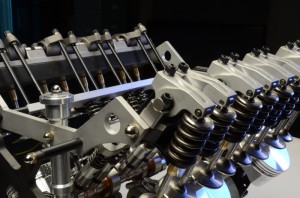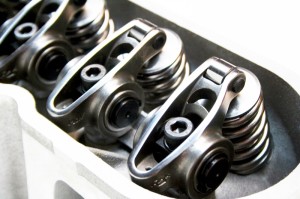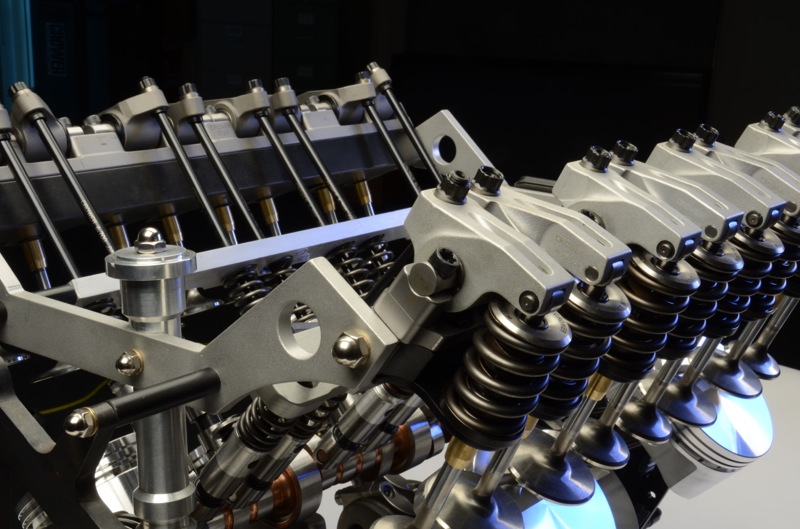
Selecting the right components to make a race-worthy valvetrain is crucial to assembling an engine that will last – and win. The pushrods, rockers and valve springs must be able to handle all of the stresses of the camshaft rotating with high spring pressures and with huge lift. As we all know, weakness in any part of the valvetrain will equal a performance engine catastrophe.
While the type of parts you choose often depends on the application (street performance, circle track, drag, marine, etc.), you also must fall within the parameters of your customer’s budget. Affordability often limits your choices if a customer just doesn’t have the bucks to build an ultimate engine.
The issue of valvetrain durability may need to be voiced by you to a customer, especially with endurance racing where the engine is expected to last a certain number of laps without any valvetrain failures.
The thought process that you go through when planning the valvetrain components for an engine build is usually based on your past experience. Unless you’re pushing the envelope or experimenting with something new, you tend to stick with the same brands and types of parts you’ve used successfully in previous engines.
The safe approach here is – “if it isn’t broken, don’t fix it, right?”
But there may come a time that you need to build an engine for an extremely competitive class where a few extra horsepower may make the difference between winning and losing. When these cases come into your shop, you may have no other choice but to try different valvetrain components to see if there’s any ground to be gained.
Pushrods
Stock pushrods are okay for stock engines, but are usually not stiff enough to handle stronger-than-stock valve springs. If you’re building a performance engine – stiffer is better to get your customer to the finish line.
Reducing weight in the valvetrain obviously increases an engine’s rpm potential. But the weight of the pushrods is something you don’t want to minimize because it will increase flex and the risk of bending or breakage.
The pushrods have to be stiff enough to handle the valve springs, so the stiffer the valve springs, the stiffer the pushrods need to be.
Weight on the pushrod side of the rocker arms has much less effect than weight on the valve side of the rocker arm. The lift ratio of the rocker arms has a leverage effect that multiplies spring pressure when the valves close.
Chrome-moly pushrods are a step up, and for serious racing the pushrods will also have to be thicker walled (.080˝ minimum), larger diameter and possibly tapered (if they’ll fit and you are not using guide plates). Some aftermarket performance pushrods are available in wall thicknesses up to .125˝, and others use a double wall construction with an aluminum tube inside a steel outer tube. The inner tube adds stiffness and weight. And if you’re worried about weight, don’t be because added mass on the pushrod side of the rockers is much less important than mass on the valve side.
If you’re not sure how much pushrod stiffness a motor needs, check with your pushrod supplier. They can advise you on what pushrods to use based on the application, cam and valve springs. As one pushrod supplier put it, “The same cam and valve springs in one kind of racing application may require pushrods that are different from those that would be the best choice for a different type of application. Everything is very specialized today, so you have to consider all the variables, not just the cam grind and valve springs.”
Pushrod Fit
Pushrod lengths are often custom-sized to fit a performance engine. The length of the pushrod will depend on a number of factors, including the installed height of the valves, the centerline and geometry of the rocker arms, and the position of the cam base circle relative to the block and heads.
Pushrods have to be correctly sized to keep the tips of the rockers centered over the valves as they open and close. Wrong length pushrods can result in side loading on the valves, uneven valve stem and guide wear, and pushrod bending and breakage.
The tip of a roller rocker arm should be centered over the valve stem when the cam is at mid-lift. If it is off-center, it will produce side loading on the valve stem.
An adjustable-length pushrod or similar pushrod measuring device can be used to determine the correct size. Install the adjustable pushrod, adjust valve lash as it will be set on the engine (zero lash if you are using hydraulic lifters), then measure the length of the pushrod.
Round-off the length to the nearest .050˝, since that’s the increment that most custom pushrods are made to size. Check with the pushrod supplier to see if they measure pushrod length end-to-end, or if they add a compensation factor for the oil holes in each end.
If an engine has cup-end pushrods rather than rounded-end pushrods, measuring the length can be tricky because the size and shape of the cup can vary depending on the manufacturer. One trick is to place a 5/16˝(.3125˝) steel ball in the cup-end, measure the overall length of the pushrod with the ball in place, then deduct the diameter of the ball to get the true length of the pushrod.

Valve Springs
With high-revving engines, stiffer is not only better, it’s a must. Stock valve springs can keep up with the demands of the valvetrain to about 5,500 to 6,000 rpm, but beyond that the engine will need stiffer springs, double springs or possibly even triple springs depending on the engine’s redline, the lift and duration of the cam, and the weight of the valvetrain components on both sides of the rocker.
Increasing the rocker arm lift ratio generally requires increasing the spring rate to maintain the same rpm potential. Going from a 1.5 rocker ratio to a 1.6 ratio may require a valve spring that is about 6.5 to 7% stiffer to maintain the same redline as before.
Spring harmonics also play a big role in how many rpms a set of springs can handle before the valves start to float. Beehive springs with their tapered profile tend to be more resistant to harmonics than conventional coil springs. But the shape of a beehive spring means you can’t use a double spring – so there’s no backup if you break a spring (as is the case with double springs).
How much spring pressure do you actually need? If you are building a mild-performance small block engine with a flat tappet cam and no more than .450˝ lift, single springs with 80 to 90 lbs. of closed seat pressure should work just fine. For a hotter street/strip engine with a flat tappet cam, single springs with 100 to 120 lbs. of closed seat pressure (300 to 330 lbs. open pressure) are usually recommended. If the engine has a roller cam with heavier lifters, you might need springs with 120 to as much as 250 lbs. of closed pressure depending on the cam grind, the weight of the valvetrain components and peak engine rpm.
For a high-revving circle track or drag racing engine that is running a flat tappet cam, double springs with closed seat pressures of 130 up to 200-plus lbs. may be needed to handle the rpms. Many Pro Stock drag racers are using triple springs with up to 475 lbs. of closed seat pressure, and over 1,000 lbs. of open valve pressure. In most instances the open spring pressure will be two to three times the closed seat pressure, so the valvetrain must be strong enough to handle it.
The main disadvantage with higher spring pressures (besides the load they create on the valvetrain) is that stiffer springs don’t last as long as springs with less spring tension. That might not be a big deal on a drag motor where the springs can be replaced often, but on a street car or endurance engine, short spring life would not be desirable.
An important point to remember is that good quality springs are expensive. Watch out for cheap springs that seem like a bargain, but won’t hold up and will lose pressure quickly or break.
Strengthening Springs
The quality of spring wire from some suppliers has increased significantly in recent years. The best springs are made from “super clean wire” that is a high grade alloy with almost no inclusions or imperfections. When the wire is formed, it is rolled in such a way that any inclusions in its microstructure are pushed to the center of the wire.
The center experiences the least stress, so the overall strength and durability of the wire is enhanced. The wire is then scanned with an electrical eddy current to reveal any hidden imperfections before it is made into a valve spring.
Some spring manufacturers are also using special surface finishing procedures to extend spring life. Shot peening has long been used to create compressive residual stresses in the outer layer of the spring wire. Shot peening leaves a matte finish on the springs, while hardening the surface to help the spring handle higher loads and speeds without failing.
Nitriding has a similar effect. By diffusing nitrogen into the surface of the spring, the surface is made harder and stronger. Polishing is another technique that can eliminate small surface imperfections and extend spring life. Springs can also be cryogenically treated to improve their metallurgy and longevity.
However, if cost is not an issue, titanium springs are the way to go. Titanium is lighter than steel and the springs are typically made with larger diameter wire but fewer coils. This allows a titanium spring to handle more valve lift without coil bind. The reduced mass and inertia of a titanium spring also increase the natural frequency of the spring to lessen harmonics at higher engine speeds. Titanium also has a lower torsional modulus than steel which makes it more springy than steel. Consequently, the springs hold their pressure longer and resist taking a set at elevated temperatures.
With conventional steel springs and beehive springs, the quality and purity of the wire are extremely important for spring reliability and longevity. Most valve springs are now made from high silicon wire or chrome vanadium wire. Ovate shaped wire can also provide some longevity advantages over round wire, and a spring made of ovate wire can handle more valve lift without coil bind. Surface treatments that micropeen and/or polish the springs reduce stress that can lead to spring breakage. One supplier of valve springs who uses a special microfinish process on its springs says it improves spring durability at least 10%. Springs can also be nitrited to improve durability.

Rock On
Valvetrain stability also depends on the rocker system. Shaft-mounted rockers are much more rigid and stronger than stud or pedestal-mounted rockers, and don’t require a bulky stud girdle for reinforcement. But shaft-mounted rocker systems are expensive and may not be allowed by some racing rules.
The advantages of a shaft rocker setup is that the shaft holds the rockers in better alignment, eliminating the need for a separate guide plate for the pushrods. This reduces flex in the valvetrain at higher speeds for better valve control. The shaft can also supply oil pressure directly to the rockers to improve lubrication and reduce friction.
The position of the shaft may also lower the pivot point of the rockers slightly with respect to the valves and pushrods. The improved geometry of shaft-mounted rockers reduces friction between the tips of the arms and top of the valves, and is typically good for an extra 15 to 20 horsepower with no other changes.
Choosing rockers with a higher lift ratio can add horsepower with little or no loss in low rpm torque, idle quality or vacuum. By opening and closing the valves at a faster rate, the engine flows more air for the same number of degrees of valve duration. High lift rocker arms also reduce the amount of lifter travel needed to open the valves, which reduces friction and the inertia of the lifters and pushrods that must be overcome by the valve springs to close the valves.
On the other hand, you also have to make sure the valve springs can handle higher ratio rockers so the coils don’t bind and bottom out. You also need to check clearances between the top of the valve guides and the underside of the spring retainers to make sure there’s enough space to handle the extra motion.
Roller lifters have much less friction than flat tappet lifters, and they don’t have the lubrication, cam break-in and wear issues that flat tappet lifters can have with low zinc oils. A roller cam also allows more radical lobe profiles and faster valve opening and closing rates for more “area under the curve” (valve opening) to make more horsepower and torque.
The main advantage of roller lifters is that they provide a huge reduction in friction compared to flat tappet lifters. This not only reduces parasitic horsepower loss in the valvetrain, but also wear on the cam lobes.
Lubrication is less of an issue with roller lifters, but is still important in performance engines with high spring pressures. At higher rpms, the rollers on the bottoms of the lifters may skip and slide rather than rotate. So the need for a good anti-wear
additive in the oil is still important (though less critical than with flat tappet lifters).
Roller lifters also provide another important advantage over flat bottom lifters: they allow more radical lobe profiles and faster valve opening and closing rates. That means more “area under the curve” (valve opening) for more horsepower and torque.
The drawbacks with roller lifters are added complexity and cost. Roller lifters can be heavier than flat tappet lifters, and may require a hinged lever between adjacent lifters to keep the lifters in proper alignment (if the lifters don’t have a flat on one side to prevent them from rotating out of position).
The most critical area in a roller lifter is the roller bearing. If the needle bearings are not perfectly matched in size, the largest one will bear most of the load and eventually fail. One supplier said they size their needle bearings to the nearest micron and carefully match all the needle bearings to improve the durability of their roller lifters.
The advantage of flat tappet lifters is that they are relatively simple and cheap compared to roller lifters. With solid lifters, there’s not much that can go wrong. The lifter is nothing more than a hollow steel bucket with a slightly convex bottom. The lifter rides on the cam lobe and transfers the rotary motion of the lobe into vertical lift. That motion passes up through the pushrods to operate the rocker arms and open the valves.
Solid lifters work well in high-revving engines, but do require constant valve lash adjustments. A solid lifter valvetrain is also quite noisy because of the clearances between the rocker arms and valves. That’s not an issue in a race car, but for a street car it may be a consideration. However, solid lifters do provide the ability to change the valve lash by adjusting the rocker arms or pushrods. This allows cam lift and duration to be tuned slightly to adapt to changing track conditions.
With hydraulic lifters, there’s an oil-filled bucket inside the lifter. Oil pressure enters the lifter through a small hole in the side and fills the piston cavity. A check ball and spring in the lifter trap the oil temporarily, allowing the piston to move upward and take up slack in the valvetrain.
This eliminates valve lash, noise and the need for frequent adjustments. But the trade off is added complexity, cost and a tendency to “pump up” at higher rpms. Hydraulic lifters are usually the best choice for stock engines, street performance applications and low rpm torque motors that don’t rev much beyond 5,500 to 6,000 rpm.














